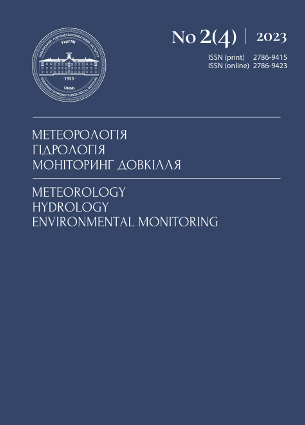DETERMINATION OF FLOW CHARACTERISTICS OF THE LOWER DNIPRO TAKING INTO ACCOUNT THE EXPLOSION OF KAHOVKA HPP
Ukrainian Hydrometeorological Institute of the State Emergency Service of Ukraine and the National Academy of Sciences of Ukraine
https://orcid.org/0000-0002-9785-9019
Perevozchykov Illia
Ukrainian Hydrometeorological Center of the State Emergency Service of Ukraine
https://orcid.org/
Oreshchenko Andrii
Ukrainian Hydrometeorological Institute of the State Emergency Service of Ukraine and the National Academy of Sciences of Ukraine
https://orcid.org/0000-0002-8363-6885
Mala Liudmyla
Ukrainian Hydrometeorological Center of the State Emergency Service of Ukraine
https://orcid.org/
Abstract
References
1. DAWR. (2020). Water balance for the Lower Dnipro Subbasin area of the Dnipro River Basin. Retrieved from https://davr.gov.ua/fls18/dnipro.pdf
2. DAWR. (2023). USE OF WATER FOR DIFFERENT NEEDS. Retrieved from https://e-services.davr.gov.ua/parlor/p-report-genn-advanced/generate?type=5&year=2023
3. Deep State Map. Отримано з https://deepstatemap.live/?info=true#8/46.288/30.987
4. Determination of Calculated Hydrological Characteristics according to SNiP 2.01.14-83. (1983). Moscow: State Committee of the USSR for Construction Affairs. [in Russian]
5. Gleick, P. H., & Shimabuku, M. (2023). Water-related conflicts: definitions, data, and trends from the water conflict chronology. Environmental Research Letters, 18(3), 034022. https://doi.org/10.1088/1748-9326/acbb8f
6. Guidebook for Determining Key Hydrological Characteristics. (1984). Leningrad: Hydrometeoizdat. [in Russian]
7. Guidelines for performing tasks in the discipline 'Mathematical Methods in Hydrometeorology'. (2010). Compiled by O.I. Lukyanets. Kyiv: VPC 'Kyiv University'. [in Ukrainian]
8. Hydrological and Water Balance Calculations. (1987). Ed. by N.G. Halushchenko. Kyiv: Vysha Shkola. [in Russian]
9. Obukhov E. V. (2012) Kakhov Reservoir - 55 years. Ukrainian Hydrometeorological Journal, 10, 116-125. [in Ukrainian]
10. Order of the Ministry of Environmental Protection and Natural Resources of Ukraine dated May 27, 2022, No. 210. (2022). Rules for the operation of the Dnipro Cascade reservoirs. Retrieved from https://zakononline.com.ua/documents/show/508275___698017#n14
11. United Nations Environment Programme. (2023). Rapid Environmental Assessment of Kakhovka Dam Breach; Ukraine, 2023. Nairobi, Kenya. https://doi.org/10.59117/20.500.11822/43696

